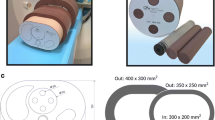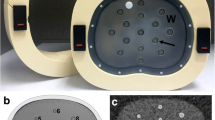Abstract
Purpose
To assess the accuracy of dual-energy CT (DECT) for the quantification of iodine concentrations in a thoracic phantom across various cardiac DECT protocols and simulated patient sizes.
Materials and methods
Experiments were performed on first- and second-generation dual-source CT (DSCT) systems in DECT mode using various cardiac DECT protocols. An anthropomorphic thoracic phantom was equipped with tubular inserts containing known iodine concentrations (0–20 mg/mL) in the cardiac chamber and up to two fat-equivalent rings to simulate different patient sizes. DECT-derived iodine concentrations were measured using dedicated software and compared to true concentrations. General linear regression models were used to identify predictors of measurement accuracy
Results
Correlation between measured and true iodine concentrations (n = 72) across CT systems and protocols was excellent (R = 0.994–0.997, P < 0.0001). Mean measurement errors were 3.0 ± 7.0 % and −2.9 ± 3.8 % for first- and second-generation DSCT, respectively. This error increased with simulated patient size. The second-generation DSCT showed the most stable measurements across a wide range of iodine concentrations and simulated patient sizes.
Conclusion
Overall, DECT provides accurate measurements of iodine concentrations across cardiac CT protocols, strengthening the case for DECT-derived blood volume estimates as a surrogate of myocardial blood supply.
Key Points
• Dual-energy CT provides new opportunities for quantitative assessment in cardiac imaging.
• DECT can quantify myocardial iodine as a surrogate for myocardial perfusion.
• DECT measurements of iodine concentrations are overall very accurate.
• The accuracy of such measurements decreases as patient size increases.



Similar content being viewed by others
Abbreviations
- DECT:
-
Dual-energy computed tomography
- DSCT:
-
Dual-source computed tomography
- ROI:
-
Region of interest
References
Flohr TG, McCollough CH, Bruder H et al (2006) First performance evaluation of a dual-source CT (DSCT) system. Eur Radiol 16:256–268
Johnson TR, Krauss B, Sedlmair M et al (2007) Material differentiation by dual energy CT: initial experience. Eur Radiol 17:1510–1517
Ko SM, Choi JW, Song MG et al (2011) Myocardial perfusion imaging using adenosine-induced stress dual-energy computed tomography of the heart: comparison with cardiac magnetic resonance imaging and conventional coronary angiography. Eur Radiol 21:26–35
Ruzsics B, Lee H, Zwerner PL, Gebregziabher M, Costello P, Schoepf UJ (2008) Dual-energy CT of the heart for diagnosing coronary artery stenosis and myocardial ischemia-initial experience. Eur Radiol 18:2414–2424
Schwarz F, Ruzsics B, Schoepf UJ et al (2008) Dual-energy CT of the heart–principles and protocols. Eur J Radiol 68:423–433
Wang R, Yu W, Wang Y et al (2011) Incremental value of dual-energy CT to coronary CT angiography for the detection of significant coronary stenosis: comparison with quantitative coronary angiography and single photon emission computed tomography. Int J Cardiovasc Imaging 27:647–656
Vliegenthart R, Henzler T, Moscariello A et al (2012) CT of coronary heart disease: Part 1, CT of myocardial infarction, ischemia, and viability. AJR Am J Roentgenol 198:531–547
Ravenel JG, Leue WM, Nietert PJ, Miller JV, Taylor KK, Silvestri GA (2008) Pulmonary nodule volume: effects of reconstruction parameters on automated measurements–a phantom study. Radiology 247:400–408
Primak AN, Ramirez Giraldo JC, Liu X, Yu L, McCollough CH (2009) Improved dual-energy material discrimination for dual-source CT by means of additional spectral filtration. Med Phys 36:1359–1369
Karlo C, Lauber A, Gotti RP et al (2011) Dual-energy CT with tin filter technology for the discrimination of renal lesion proxies containing blood, protein, and contrast-agent. An experimental phantom study. Eur Radiol 21:385–392
Schenzle JC, Sommer WH, Neumaier K et al (2010) Dual energy CT of the chest: how about the dose? Invest Radiol 45:347–353
Zhang LJ, Peng J, Wu SY, Yeh BM, Zhou CS, Lu GM (2010) Dual source dual-energy computed tomography of acute myocardial infarction: correlation with histopathologic findings in a canine model. Invest Radiol 45:290–297
Vliegenthart R, Pelgrim GJ, Ebersberger U, Rowe GW, Oudkerk M, Schoepf UJ (2012) Dual-energy CT of the heart. AJR Am J Roentgenol 199:S54–S63
Ruzsics B, Schwarz F, Schoepf UJ et al (2009) Comparison of dual-energy computed tomography of the heart with single photon emission computed tomography for assessment of coronary artery stenosis and of the myocardial blood supply. Am J Cardiol 104:318–326
So A, Hsieh J, Imai Y et al (2012) Prospectively ECG-triggered rapid kV-switching dual-energy CT for quantitative imaging of myocardial perfusion. JACC Cardiovasc Imaging 5:829–836
Ko SM, Choi JW, Hwang HK, Song MG, Shin JK, Chee HK (2012) Diagnostic performance of combined noninvasive anatomic and functional assessment with dual-source CT and adenosine-induced stress dual-energy CT for detection of significant coronary stenosis. AJR Am J Roentgenol 198:512–520
Arnoldi E, Lee YS, Ruzsics B et al (2011) CT detection of myocardial blood volume deficits: dual-energy CT compared with single-energy CT spectra. J Cardiovasc Comput Tomogr 5:421–429
Hoffmann U, Truong QA, Schoenfeld DA et al (2012) Coronary CT angiography versus standard evaluation in acute chest pain. N Engl J Med 367:299–308
Graser A, Becker CR, Staehler M et al (2010) Single-phase dual-energy CT allows for characterization of renal masses as benign or malignant. Invest Radiol 45:399–405
Chandarana H, Megibow AJ, Cohen BA et al (2011) Iodine quantification with dual-energy CT: phantom study and preliminary experience with renal masses. AJR Am J Roentgenol 196:W693–W700
Song KD, Kim CK, Park BK, Kim B (2011) Utility of iodine overlay technique and virtual unenhanced images for the characterization of renal masses by dual-energy CT. AJR Am J Roentgenol 197:W1076–W1082
De Cecco CN, Darnell A, Rengo M et al (2012) Dual-energy CT: oncologic applications. AJR Am J Roentgenol 199:S98–S105
Meinel FG, Graef A, Thieme SF et al (2013) Assessing pulmonary perfusion in emphysema: automated quantification of perfused blood volume in dual-energy CTPA. Invest Radiol 48:79–85
Meinel FG, Graef A, Bamberg F et al (2013) Effectiveness of automated quantification of pulmonary perfused blood volume using dual-energy CTPA for the Severity assessment of acute pulmonary embolism. Invest Radiol. doi:10.1097/RLI.0b013e3182879482
Acknowledgements
Dr. Schoepf is a consultant for and receives research support from Bayer, Bracco, GE, Medrad, and Siemens. Dr. Schmidt and Dr. Flohr are Siemens employees. The other authors have no potential conflicts of interest to disclose.
The project described was supported by award number UL1TR000062 from the National Center for Research Resources. The content is solely the responsibility of the authors and does not necessarily represent the official views of the National Center for Research Resources or the National Institutes of Health.
Author information
Authors and Affiliations
Corresponding author
Rights and permissions
About this article
Cite this article
Koonce, J.D., Vliegenthart, R., Schoepf, U.J. et al. Accuracy of dual-energy computed tomography for the measurement of iodine concentration using cardiac CT protocols: validation in a phantom model. Eur Radiol 24, 512–518 (2014). https://doi.org/10.1007/s00330-013-3040-6
Received:
Revised:
Accepted:
Published:
Issue Date:
DOI: https://doi.org/10.1007/s00330-013-3040-6




